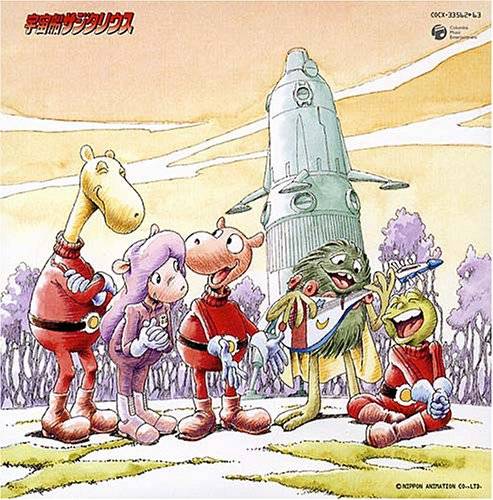
Thanks to Hironobu Kageyama’s contributions to Dragon Ball Z, mostly notably the two opening themes, many fans around the world refer to him as Mr. DBZ. However, his legacy obviously goes beyond Dragon Ball Z. So, what led him to be one of anime’s most famous composers? Read our history report to find out!
Kageyama was born and raised in Osaka, and his family ran a barber shop. Though his name in Japanese tends to be written as 影山ヒロノブ, his name is actually written as 景山浩宣 (they are pronounced the name). As to why he changed the “kage” kanji in his stage name, it was just to distinguish himself from the commonly written way. When he was in high school, he started a band with another famous Japanese musician, Akira Takasaki, who he was childhood friends with. The name of their band was Lazy. During that period, he performed under the stage name of “Michelle,” and they would go on local radio shows. After splitting in May of 1981, he made his solo debut in October of that year. At the time, he did whatever he could to promote himself and get on a few national TV shows to do so.
As for Kageyama’s break out into Japanese anime, he made his debut in that world with Star Dust Memory, for Southern Cross, which some of you older folks may know as one of the seasons to Robotech. Though it wasn’t an opening theme song, it was an insert song in episode 9. However, his first contribution in relation to opening and ending themes in anime was with 1986’s Uchuusen Sagittarius. He served as the vocals while Yuu Aku wrote the lyrics, and Kisaburo Suzuki, one of the biggest composers of the 80’s, composed the song.
Shortly prior to contributing to the openings of Uchuusen Sagittarius, Kageyama’s first crack at that was with Dengeki Sentai Changeman, the 1985-1986 Super Sentai show. What made the opening theme distinct was that it was the first Sentai theme to use a shuffle beat, which was in style with anime at the time. A couple of decades later, it was once again popularized as the entrance theme to MMA fighter, Rodrigo Gracie of Brazil. Later on, he would continue to contribute to Super Sentai with Maskman, Jetman, Fiveman, and Garo (which we’ll get into later).
After Uchuusen Sagittarius, Kageyama’s career both in terms as a musician and in contributing to modern pop culture as a whole just exploded. In 1987, he then performed the opening and ending themes to The Headmasters season of Transformers, which largely stayed exclusive in Japan for nearly 3 decades! A year later in 1988, he sung the second opening and ending themes to Saint Seiya, which also become huge hits in its native Japan. Then finally in 1989, his career as an international star was solidified when Cha-La Head Cha-La served as the first opening theme to Dragon Ball Z. Even prior to being selected to perform the theme song, Kageyama was already a long time fan of Dragon Ball and when he was given the offer, he couldn’t say no.
Throughout Dragon Ball Z’s prime, he contributed to some insert songs for the show and some ending songs to the movies. Beyond Cha-La Head Cha-La and We Gotta Power, a lot of favorite DBZ hits that contributed to his becoming Mr. DBZ were Saikyou no Fusion, Spirit Vs. Spirit, Aoi Kaze no Hope, and Hikari no Will Power. If you ever buy a DBZ album, most likely, you’re going to get a song of Kageyama. Beyond the anime, he also contributed some original songs to the DBZ games such as The Biggest Fight for Final Fight, Ore Wa Tokoton Tomaranai for Budokai 3, Hikari no Sasu Mirai He for Infinity World, and Progression for Raging Blast. While he did not contribute to Dragon Ball Super, instrumental versions to Cha-La Head Cha-La were still used in episode recaps.
In addition to doing Dragon Ball, Transformers, and Saint Seiya, Kageyama released his own album that consisted of covers of other anime songs such as the theme songs to much of the Gundam franchise, and Getter Robo. Beyond the Dragon Ball games, he also contributed to the Super Robot Taisen series, the opening theme to Goemon for the N64, and made an image song for Ken for a Street Fighter II album. So, he’s done almost a bit of everything.
Final Thoughts

Since 2000, Kageyama has been a long time collaborator for JAM Project, a band consisting of musicians and singers who have contributed to anime, games, and tokusatsu. Their largest presence has been through the Garo franchise, where some seasons have been tokusatsu, and others have been anime. For every installment, the band has provided a theme song. In addition, Kageyama actually provides the voice of Zaruba, the main character’s spiritual companion who takes the form of a ring. When you hear his voice in just about any installment in Garo, you’ll be surprised how nasal he sounds, which sounds totally different to his energetic and bombastic singing voice. And speaking of seiyuus, his daughter, who goes by the stage name Risa Kayama, is presently an up and coming seiyuu herself. As for his younger daughter, Rina, she is a dancer and choreographer. Either way, Kageyama’s contributions to anime as a whole will forever live on. Maybe one day, he’ll come back to Dragon Ball (and Saint Seiya) full time as well. Until then, we will be waiting.

